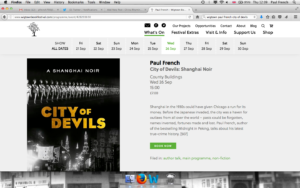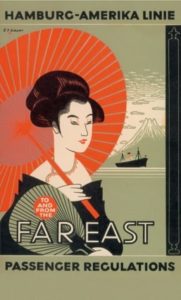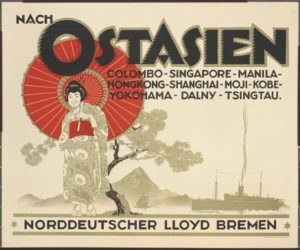Posted: September 28th, 2018 | No Comments »
The January 28 incident or Shanghai incident (January 28 – March 3, 1932) was a conflict between China and Japan. I won’t go into it in detail here – suffice to say the cartographers of the American newspapers got to work straight away. This map appeared in many American newspapers on January 31 1932….

Posted: September 21st, 2018 | No Comments »
Yes, it’s back to Wigtown – Scotland’s official book town – me, old Shanghai, talking with Roland Gulliver of the Edinburgh Book Festival and then….everything Wigtown is famous for – bookshops, pubs, salted marsh lamb…

worth the trip – click here for details

Posted: September 20th, 2018 | No Comments »
Sam Chambers of Sinoship sourced these lovely 1930s images from the Norddeutscher Lloyd line while in Hamburg (near Norddeutscher’s old base of Bremen) recently….
Enjoy – and note perhaps the spellings of Dalny (Dalian) and Tsingtau (Qingdao, and a former German treaty port of course)…also note the putting in at the port of Moji. I have rarely seen Moji on schedules from this time (or any other) with nearby Kobe (250 miles or so away) being the normal port of call. However, it was a highly western influenced port and town from the late nineteenth century as seen in the photographs here.



Posted: September 18th, 2018 | 1 Comment »
Before telex machines, pagers and mobile texts – all that LOL, BTW etc etc – there were cable codes that allowed for regularly sent short messages to save time and costs. Hotels in Shanghai, and throughout the Far East, worked out their own set of codes (you may need to click on the image below to see better)….for instance short codes for reserving rooms, transfers, forwarding mail – should you wish a bath simply send one of the codes followed by “B”. The bottom example shows you how efficient the system could be….

Posted: September 17th, 2018 | No Comments »
It’s on again!!

Bespoke Beijing and Penguin Books are proud to announce the official walking tour of Midnight in Peking, Paul French’s bestselling murder mystery.
This is your chance to retrace the footsteps of those embroiled in the grisly death of Pamela Werner (a British diplomat’s daughter) in 1930s Peking – a death that shocked the foreign community to its core.
From the ominous ‘Fox Tower’ to the gritty ‘Badlands’ and the former foreign legation quarter, two historians who have carried out painstaking additional research into the Chinese side of the case will beat a path through the little known areas of old Peking, painting a vivid picture of a period in Beijing’s history it would rather forget.
Most exciting of all, the newly uncovered Chinese police reports on the case detail several characters not mentioned in the book, offering critical new perspectives on the murder. For fans of the book, this is a tour not to be missed.
NOTE Bespoke’s public Midnight in Peking Walking Tours take place on the last Saturday of every month. The next one will be on Saturday, September 29th. To book tickets, click here!
More details and group bookings here –
Posted: September 16th, 2018 | No Comments »
Hong Kong International Literary Festival Tickets re Now On Sale
2-11 November 2018
All details here
(I’m there the first weekend by the way talking City of Devils and writing about China)

Posted: September 15th, 2018 | No Comments »
If you are in Hong Kong this will be a good event; if not the book looks like a “must have”…
Sunset Survivors
By Lindsay Varty with photography by Gary Jones
When: Thursday, September 20, 6-8pm
Where: G.O.D., 48 Hollywood Road, Central, Hong Kong
Who: All welcome. Drinks will be served!

Sunset Survivors tells the stories of Hong Kong’s traditional tradesmen and women through stunning imagery and candid interviews. Covering a myriad of curious professions that are quickly falling into obscurity, from fortune telling to face threading and letter writing to bird cage making, readers soon find themselves immersed in the streets of old Hong Kong.
Filled with interviews, photographs and little-known facts about the city’s twilight industries, Sunset Survivors is a tribute to those who keep the flame burning in a city besieged by foreign imports and stiff competition. This book is a celebration of Hong Kong’s cultural identity. It preserves the memory of these hardy men and women, and educates visitors and locals on the foundations on which the city was built.
An up-close and personal look at the industries and workers that gave rise to the Hong Kong of today, Sunset Survivors is more than just a travel or coffee-table book; it is a tribute to the city’s character, a celebration of its roots and a guide to its evolution.
In a city undergoing a dramatic cultural shift, balancing social and political upheaval, the need to document Hong Kong’s traditional livelihoods has seldom been greater. Capturing the true personality of this metropolis, Sunset Survivors is a vital piece of history.
 
Posted: September 13th, 2018 | No Comments »
It is well known that North Wales and Snowdonia has never looked so amazing as it did standing in for China in The Inn of the Sixth Happiness, the 1958 movie with Ingrid Bergman as a missionary. Towards the start of the film Bergman arrives in Tientsin (Tianjin) by train – I’d never really paid attention to this part of the movie before always sitting up when the mountains behind the Welsh village of Beddgelert appears full of Chinese people! However, the Tientsin Railway Station scenes were filmed at the MGM Studios in Borehamwood, Hertforshire. But it looks good….
















